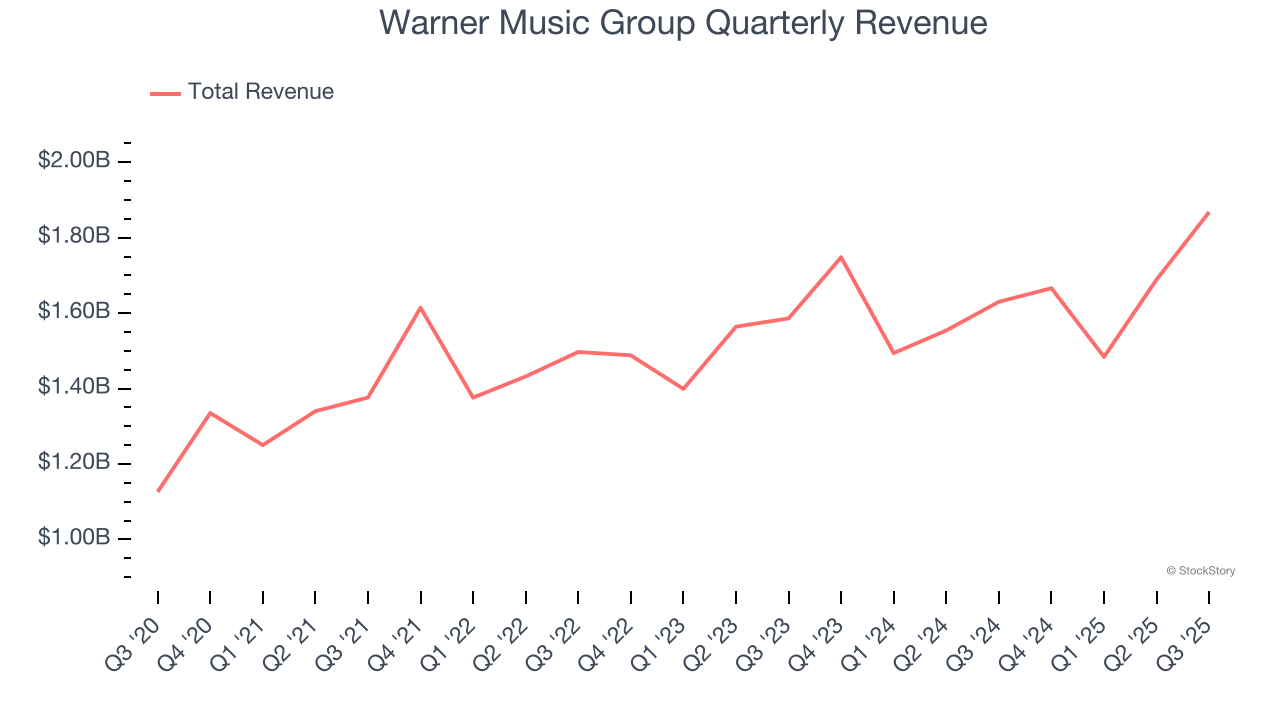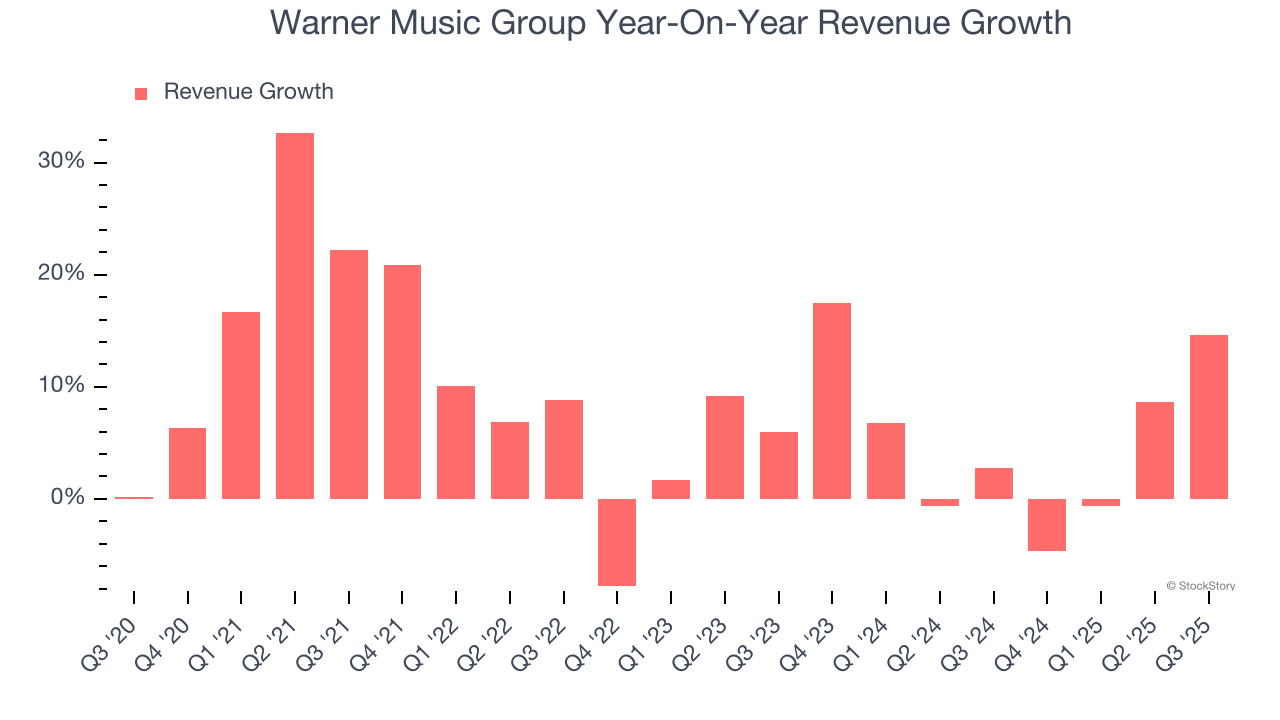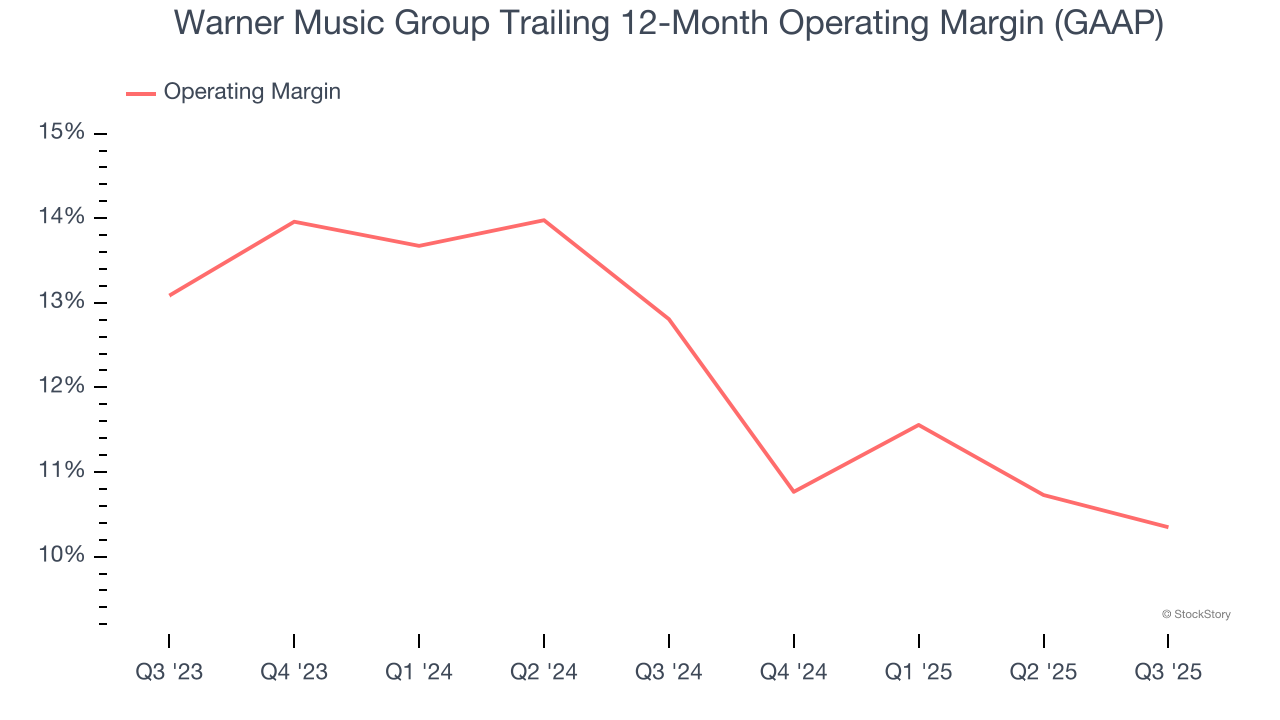
Global music entertainment company Warner Music Group (NASDAQ: WMG) beat Wall Street’s revenue expectations in Q3 CY2025, with sales up 14.6% year on year to $1.87 billion. Its GAAP profit of $0.21 per share was 38.7% below analysts’ consensus estimates.
Is now the time to buy Warner Music Group? Find out by accessing our full research report, it’s free for active Edge members.
Warner Music Group (WMG) Q3 CY2025 Highlights:
- Revenue: $1.87 billion vs analyst estimates of $1.69 billion (14.6% year-on-year growth, 10.8% beat)
- EPS (GAAP): $0.21 vs analyst expectations of $0.34 (38.7% miss)
- Adjusted EBITDA: $405 million vs analyst estimates of $373.5 million (21.7% margin, 8.4% beat)
- Operating Margin: 7.7%, down from 8.8% in the same quarter last year
- Free Cash Flow Margin: 10.9%, down from 16.6% in the same quarter last year
- Market Capitalization: $15.9 billion
"With our artists and songwriters hotter than ever, market share gains drove our quarterly revenues to an all-time high,” said Robert Kyncl, CEO, Warner Music Group.
Company Overview
Launching the careers of legendary artists like Frank Sinatra, Warner Music Group (NASDAQ: WMG) is a music company managing a diverse portfolio of artists, recordings, and music publishing services worldwide.
Revenue Growth
Reviewing a company’s long-term sales performance reveals insights into its quality. Any business can experience short-term success, but top-performing ones enjoy sustained growth for years. Unfortunately, Warner Music Group’s 8.5% annualized revenue growth over the last five years was sluggish. This fell short of our benchmark for the consumer discretionary sector and is a poor baseline for our analysis.

We at StockStory place the most emphasis on long-term growth, but within consumer discretionary, a stretched historical view may miss a company riding a successful new product or trend. Warner Music Group’s recent performance shows its demand has slowed as its annualized revenue growth of 5.4% over the last two years was below its five-year trend. 
We can dig further into the company’s revenue dynamics by analyzing its most important segments, Recorded Music and Music Publishing, which are 82.1% and 18% of revenue. Over the last two years, Warner Music Group’s Recorded Music revenue (new music production) averaged 4.6% year-on-year growth while its Music Publishing revenue (royalties from catalog music) averaged 9.9% growth. 
This quarter, Warner Music Group reported year-on-year revenue growth of 14.6%, and its $1.87 billion of revenue exceeded Wall Street’s estimates by 10.8%.
Looking ahead, sell-side analysts expect revenue to grow 2.9% over the next 12 months, a slight deceleration versus the last two years. This projection doesn't excite us and indicates its products and services will face some demand challenges.
The 1999 book Gorilla Game predicted Microsoft and Apple would dominate tech before it happened. Its thesis? Identify the platform winners early. Today, enterprise software companies embedding generative AI are becoming the new gorillas. a profitable, fast-growing enterprise software stock that is already riding the automation wave and looking to catch the generative AI next.
Operating Margin
Operating margin is a key measure of profitability. Think of it as net income - the bottom line - excluding the impact of taxes and interest on debt, which are less connected to business fundamentals.
Warner Music Group’s operating margin has shrunk over the last 12 months, but it still averaged 11.6% over the last two years, decent for a consumer discretionary business. This shows it generally does a decent job managing its expenses.

This quarter, Warner Music Group generated an operating margin profit margin of 7.7%, down 1.1 percentage points year on year. This reduction is quite minuscule and indicates the company’s overall cost structure has been relatively stable.
Earnings Per Share
We track the long-term change in earnings per share (EPS) for the same reason as long-term revenue growth. Compared to revenue, however, EPS highlights whether a company’s growth is profitable.
Warner Music Group’s full-year EPS flipped from negative to positive over the last five years. This is encouraging and shows it’s at a critical moment in its life.

In Q3, Warner Music Group reported EPS of $0.21, up from $0.08 in the same quarter last year. Despite growing year on year, this print missed analysts’ estimates, but we care more about long-term EPS growth than short-term movements. Over the next 12 months, Wall Street expects Warner Music Group’s full-year EPS of $0.70 to grow 98.1%.
Key Takeaways from Warner Music Group’s Q3 Results
We were impressed by how significantly Warner Music Group blew past analysts’ revenue expectations this quarter. We were also glad its Recorded Music revenue outperformed Wall Street’s estimates. On the other hand, its EPS missed. Overall, this print had some key positives. The stock remained flat at $30.60 immediately following the results.
So do we think Warner Music Group is an attractive buy at the current price? When making that decision, it’s important to consider its valuation, business qualities, as well as what has happened in the latest quarter. We cover that in our actionable full research report which you can read here, it’s free for active Edge members.





